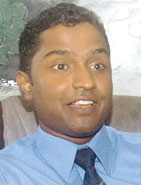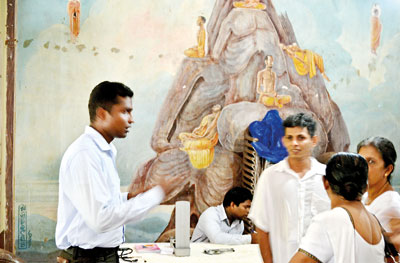Taking Ayurveda into the 21st century
Guided by his parents , both Ayurvedic physicians Dr. Hasitha Kothalawala practises the ancient art of healing with a modern touch
At first glance, Hasitha Kothalawala looks nothing like a traditional Ayurvedic doctor. Dressed in a crisp shirt and tie, his hair smoothly slicked down, he’s the epitome of a successful young executive. In his office, there’s no sight of a kuppi laden with beheth-thel anywhere. Yet when he speaks it’s immediately clear that his world is Ayurvedic medicine.

Dr. Hasitha Kothalawala
“This is not just a means of treatment, but rather a philosophy,” he explains. “It’s an art that is mastered with precision, and a right that is earned under the guidance of a master.” At 28, Dr. Hasitha Kothalawala, is an Ayurvedic orthopaedic consultant at the Siddhalepa Hospital in Mount Lavinia. For him Ayurveda was a family inheritance so to speak, as he learnt under the watchful eye of his late father P.S. Kothalawala, better known as the Hathlahagoda Veda Mahaththaya -who served as the private practitioner to the President at the time- and his mother I.V.S. Kothalawala, the Vedha Haamine.
The Ayurvedic medical system is one that encompasses Sinhala traditional medicine and the Siddha systems of India. These teachings were handed down for over 3000 years by physicians, and King Buddhadasa (4th Century AD), the most influential of these physicians, wrote the ‘Sarartha Sangrahaya’, a comprehensive Ayurvedic manuscript. The system used now amalgamates both the Lankan and Indian but the form of orthopaedic Ayurveda is indigenous to Sri Lanka, he explains.
What Dr. Hasitha specialises in is the treatment of spine problems, from which more than 85 % of his patients suffer. “Nobody has a perfect spine,” he says, “but with more and more people being hunched over computers and workstations, spine problems have aggravated.” Dr. Hasitha has made a name for himself, as a spine specialist and believes, it is what he was destined to do – much like his father who was renowned for treating fractures and dislocations.
The young doctor says he is proud to be a stakeholder in the resurgence of Ayurveda. “Many people would question the wonders of this art, and this is mainly because of the innumerable scams and frauds that people have fallen prey to in the recent past,” he says, telling us that there is no voodoo or magic involved in it, but rather an amalgamation of science, experience and the athguney, or healing touch. “The problem is that people most often like to follow the magic and not the logic,” he smiles.
The patient’s state of mind is important, he stresses. If the patient builds enough confidence in the doctor, then half the workload is done. The rudimentary principles of ayurvedic treatment lies on watha (air), pitha (enzymes and hormones), and kapa (phlegm), and it is an intimate balance of these three elements that bring about the wellbeing of a patient. A practitioner would diagnose the symptoms, but would treat the root cause, rather than temporarily getting rid of the symptoms. “The fundamentals lie in finding the cause and treating it right from its root, and that’s why Ayurvedic treatment takes a considerably longer time than Western medicine,” he says.
There are 18 ailments that come without cause, he says. “This is where our forefathers had been very savvy in treating patients with these,” he goes on. The ancient ritual of the daha-ata sanniya is in fact an act to symbolise the unknown malady in the form of a devil, which would come forth and demand an offering from the patient in return for good health. This would be the necessary herbs and ingredients used in making the cure. The patient, unaware of this believes that the devil is what has been causing the illness, and becomes convinced that he is cured once the devil’s wishes have been satisfied. Eighteen such devils take the centre-stage in this ancient ritual which once again reiterates the importance of making a patient psychologically confident of a cure.

Dr. Hasitha conducting a health camp at Mithirigala
Dr. Hasitha recalls how people would come to his father seeking treatment. “The patients would be curled up in pain, screaming. They had to be carried by two or three people.” His father would take on any case, and remarkably enough, after a week or so, the same patients would happily march into their house and fall to their knees. Budu mahaththayata pin sidda wenawa, (May you gain bountiful good merit) they would say, worshipping his father. “Such was the wonder behind our profession. That gratitude cannot be bought for money.”
It is this that engraved a passion for medicine in Dr. Hasitha. “Be it Western or Ayurvedic medicine- that is what we all yearn for. There is nothing to match that satisfaction,” he enthuses.
His father Ayurvedic doctor P. S. Kothalawala was the Chairman of the Ayurvedic Drugs Corporation from 1994-1998. He studied under Ven. Vidagama Piyarathana Thero, at the Vidagama temple renowned for its great Ayurvedic history. Life was challenging for he had even had to wash the herd of cattle to earn the right to peruse one book of medical scriptures. “My father always said that the monks would often hint that the dry leaves will fall off soon, and only the sturdy would remain,” Dr. Hasitha mentions. Sure enough, young Kothalawala was a sturdy leaf. It took him 13 long years and finally in 1968, he qualified as an Ayurvedic practitioner under the Medical Council.
He then set up the Vidagama Oushadha Sapayanno (Vidagama Medical Suppliers) and started producing his own medicine, made of natural herbs that were carefully collected. It was an uphill but steady progress as he became known all around the country for his healing skills. However, he died of a sudden heart-attack aged just 59, just as Hasitha was turning 14.
“My father would tell me that I would first have to pick, grind, and boil before getting my degree. This profession is not something that is limited to books, it goes beyond that, and the entire process starts with producing the medicine,” says Dr. Hasitha.
After his father’s death, Hasitha was taught by his mother, I.V.S Kothalawala, who also took up her husband’s profession. She was initially a matron, but learnt Ayurveda under her husband for 14 years. Hamademay akuratama igenagaththa, she says, that she learnt the art meticulously, and thus was able to hand it over to her sons. It was the greatest dream of the Veda Mahaththaya to see his sons following in his footsteps. A dream fulfilled it was, when the young Royalist decided to widen his horizons under the teaching of his mother.
“Many questioned my mother as to why she was letting me take up Ayurvedic medicine, even after attending such a prestigious school. But, she braved all the criticism and got me to where I am today, because she felt she had a responsibility to fulfil my father’s vision,” says Dr. Hasitha proudly.
From 2005, Hasitha would sit by his mother’s side and apply beheth thel on the patients’ legs. “Putting up with the screaming was the hardest part,” he laughs, “you occasionally get kicked in the face too!” In 2011, he was registered as a traditional doctor at the Ayurvedic Medical Council, which requires a state certification that the holder has been practising Ayurvedic medicine under the guidance of a qualified Ayurvedic practitioner for well over five years. In March 2012, Hasitha sat for his ‘viva’ exam and passed with distinctions to become one of the youngest qualified Ayurvedic practitioners in the country.
His twin brother chose to go into marketing and Dr. Hasitha believes it is for the best since his skills help in their operation.
He is all for progress and using modern diagnostic tools in the practice of this ancient art of healing. “There are many Ayurvedic practitioners who are against the use of technology, but what’s wrong with it?” he asks. “There’s nothing wrong in being an Ayurvedic practitioner and using an X-Ray or an MRI scan, to gain a better understanding of the patient,” he says.
With the setting up of the Siddhalepa Ayurveda Hospital, many believe that the required facilities and training are falling into place, but Dr. Hasitha believes that much more needs to be done in forging trust in the hearts of people. “There needs to be much more awareness about this field, and the possibilities that lie in it for young people like us,” he says. “Ayurveda needs to move forward, and we cannot do this by holding on to all the ways of our forefathers.”
Follow @timesonlinelk
comments powered by Disqus


